Bread and bakery deliveries to homes, early 20th century UK
Bread and bakery deliveries to early 20th century households were frequent, regular and reliable. This page explains why and gives some firsthand experiences of the system. The page is well illustrated with bakers' delivery hand carts and horse-drawn wagons. Also included is how payment for deliveries was made and how deliveries changed in the First World War.
____
Extracted from the memoirs of the webmaster's mother (1906-2002) and edited by the webmaster with further research and firsthand contributions from others
Why bread deliveries had to be frequent, regular and reliable
Bread deliveries were frequent. They had to be was because there were no household fridges, and bread went dry or mouldy quickly, even when wrapped in a cloth and kept outside in the food safe. Deliveries to any one road were often as much as several times a day, even though the regular order for households was usually ever alternate day and daily in some households. If a family ran out of bread, it was relatively simple for someone - invariably the housewife or a child out of school hours - to spot when the baker was in the road and run out and buy a loaf on the spot. It was worth a bakery's while to deliver so frequently as sales were large. There was no charge to the customer for delivery.
The deliveries were also reliably regular. Again, they had to be because bread was a staple in families' diets. If a delivery was missed, someone in family had to go to the local bakers shop and carry the bread back home - and bread was bulky.
If deliveries were missed too often, trade would go to another bakery. There were several near where I lived.
Bread delivery by handcart
Bread from most bakeries was delivered by handcart. The of all of them was style was identical. They had a two large wheels with wooden legs at the back for support while stationary. They were automatically lifted up while being wheeled, like today's wheelbarrows. These handcarts were always covered to protect the bakers' wares from rain and dirt, and the name of the baker was always painted on the sides. The following photos show three such handcarts.
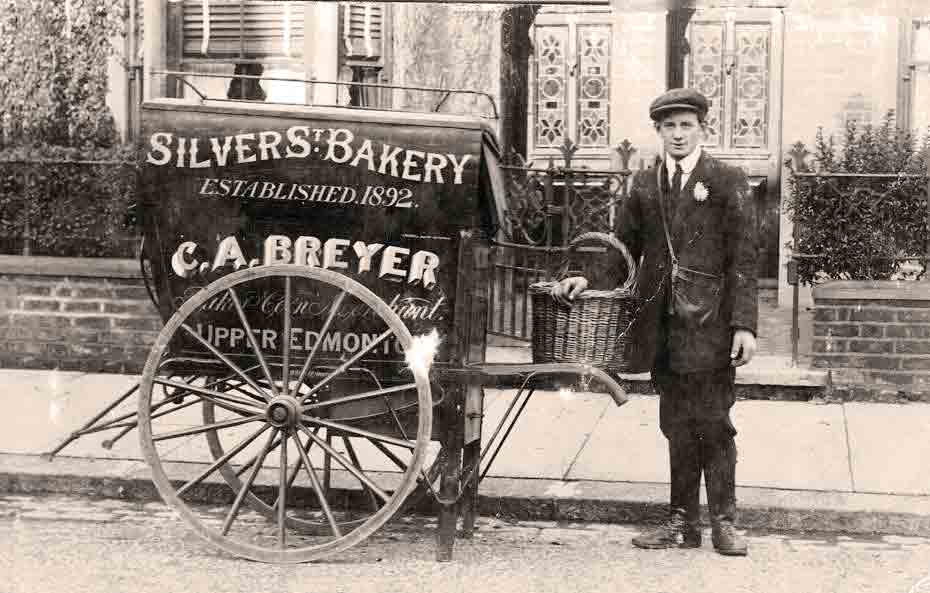
Two-wheel hand cart used by bakers to deliver their
wares to houses.
Photograph courtesy of the Scarff family. George Scarff (1889-1960) was the delivery boy.
The bakers' boy is George Scarff (1889-1960) delivering to Bulwer Road, Edmonton, while working for Breyers Bakery in Silver Street, Edmonton. This dates the photo to about 1903.
Bakers boys
Deliveries were usually made by young boys, known as 'baker's boys' with or without the apostrophe. They tended to have just left school at 14 and were hoping to progress in the trade. Children in the family were also used, often having to do the rounds before school.
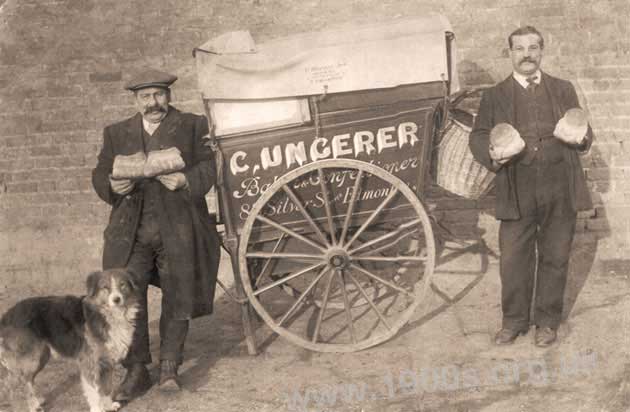
Baker's delivery hand cart from Ungerer's bakery. Charles Ungerer, who
is understood to have had a strong German accent, is on the left and the man on
the right could be an assistant.
Photo courtesy of a family member who
prefers to remain anonymous.
Note the shapes of the loaves that the men are holding, which were normal for the time.
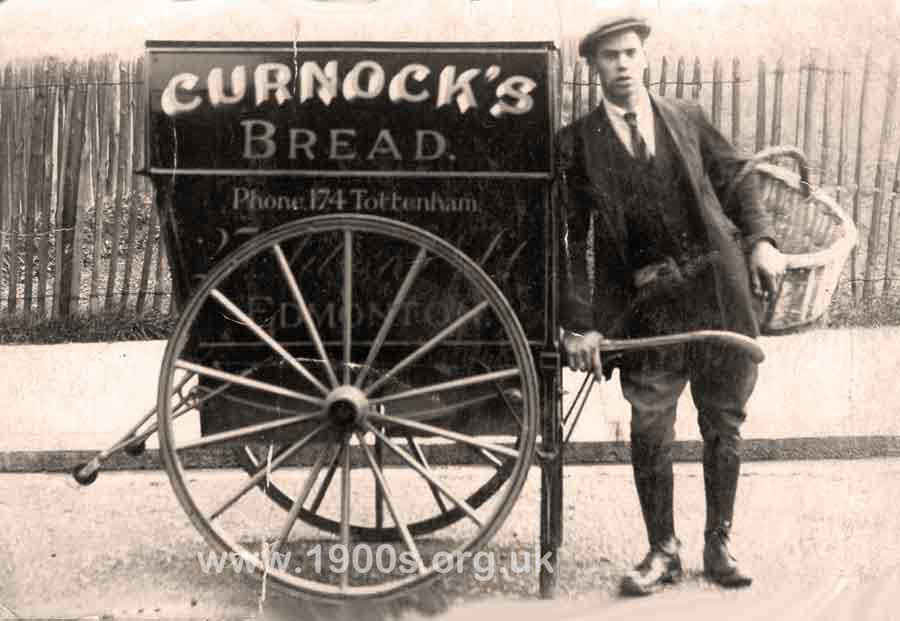
Baker's delivery hand cart from Curnock's Bakery, c1920
Bread delivery by horse and cart
'Horse and cart' is a term well-understood today which is why it is in the above heading. However, in my childhood when there were no cars or delivery vans, horse-drawn vehicles ruled the day and it was usual to specify more precisely what they were pulling. In the case of bread deliveries the usual descriptor was 'wagon' which meant that it was covered. So bread deliveries were made by horse and wagon, as shown by the following photos.
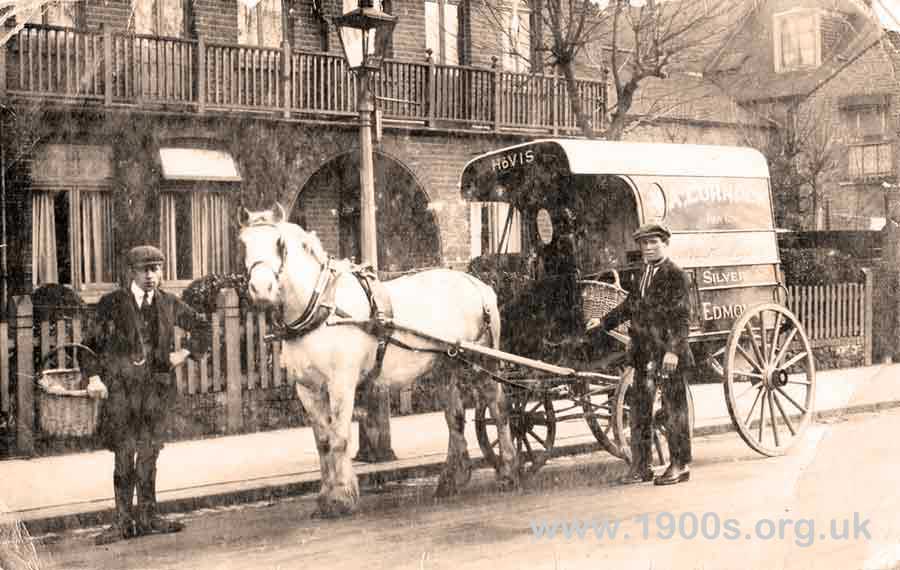
A Curnock's delivery by horse and wagon, 1929
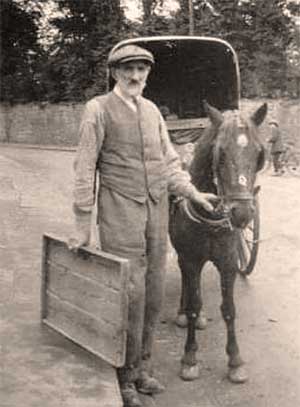
Baker delivering by horse and a small type of wagon; photo courtesy of Ken Windsor.
Note the tray made out of wooden planks, which would have been used for carrying loaves of bread and other bakery wares. As it is empty, the man must have just finished a delivery.
The baker's horse
contributed by David Perfect, recollections
Many a time as my mother and I waited for the bread to arrive for our 'elevenses', we would go out into the street to see how far the delivery had got, only to see the baker, many houses away, struggling to get the horse to stop eating the neighbour's privet hedge before continuing on.
Paying for bread delivery
No coins were touched by the boys or men making the bread deliveries. The women didn't pay for their bread as they bought it. The baker carried a book in a leather pouch, and every item was entered into it. Then women then paid for a whole week on Saturdays in the shop.
How WW1 affected deliveries
During the 1914-18 war, things changed. Men and youths of 18 were conscripted in large numbers into the forces and and patriotic younger boys who said they were 18 often managed to slip in too. So deliveries stopped, and we had to go and get our own bread from the shop.
| sources | webmaster | contact |
Text and images are copyright
If you can add anything to this page or provide a photo, please contact me.



